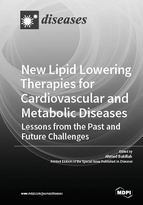New Lipid Lowering Therapies for Cardiovascular and Metabolic Diseases: Lessons from the Past and Future Challenges
A special issue of Diseases (ISSN 2079-9721). This special issue belongs to the section "Cardiology".
Deadline for manuscript submissions: closed (31 December 2018) | Viewed by 63168
Special Issue Editor
Interests: cardiovascular diseases; diabetes; obesity; atherosclerosis, biomarkers; metabolic syndrome; dyslipidemia; lipid and lipoprotein metabolism; diabetic vascular complications
Special Issues, Collections and Topics in MDPI journals
Special Issue Information
Dear Colleagues,
Remarkable research efforts have been made in lowering plasma cholesterol levels by the widespread use of statins resulting in significant reduction of death rate by ~30%–40%. Despite all these efforts, cardiovascular disease (CVD) continue to be the leading cause of mortality worldwide. Current approaches for the prevention and treatment of CVD are not fully effective in terms of risk reduction due to “residual risk” even when using a number of statin-combined therapeutic strategies. Thus, it has become obvious that development and validation of new pharmacological intervention may contribute to a better assessment of CVD risk and help in implementing new therapeutic strategies for high risk patients. After recent failure with cholesteryl ester transfer protein inhibitors, effective lipid lowering drugs emerged as new revolutionizing lipid-lowering therapy. In this context, human anti-PCSK9 antibodies have been shown in a wide range of patients, including those with statins intolerance, to significantly decrease plasma cholesterol by ~50%–70% with no alarming safety signals.
This Special Issue will provide an open access opportunity to publish research work and review articles related to recent advances in the field of CVD, new molecular insights and potential therapeutic strategies for better patient diagnosis and disease prevention.
Dr. Ahmed Bakillah
Guest Editor
Manuscript Submission Information
Manuscripts should be submitted online at www.mdpi.com by registering and logging in to this website. Once you are registered, click here to go to the submission form. Manuscripts can be submitted until the deadline. All submissions that pass pre-check are peer-reviewed. Accepted papers will be published continuously in the journal (as soon as accepted) and will be listed together on the special issue website. Research articles, review articles as well as short communications are invited. For planned papers, a title and short abstract (about 100 words) can be sent to the Editorial Office for announcement on this website.
Submitted manuscripts should not have been published previously, nor be under consideration for publication elsewhere (except conference proceedings papers). All manuscripts are thoroughly refereed through a single-blind peer-review process. A guide for authors and other relevant information for submission of manuscripts is available on the Instructions for Authors page. Diseases is an international peer-reviewed open access monthly journal published by MDPI.
Please visit the Instructions for Authors page before submitting a manuscript. The Article Processing Charge (APC) for publication in this open access journal is 1800 CHF (Swiss Francs). Submitted papers should be well formatted and use good English. Authors may use MDPI's English editing service prior to publication or during author revisions.
Keywords
- cardiovascular disease
- lipids and lipoproteins
- LDL cholesterol
- statin
- atherosclerosis
- dyslipidemia
- hypercholesterolemia
- clinical trials
- cardiovascular risk
- cholesterol lowering drugs






